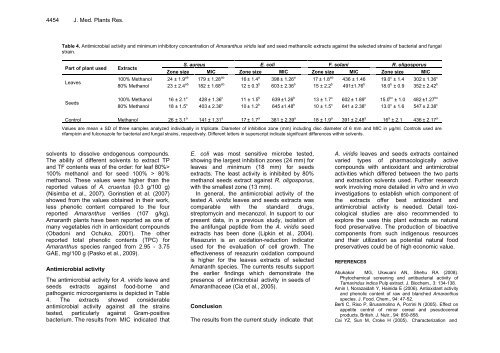Download Complete Issue (4740kb) - Academic Journals
Download Complete Issue (4740kb) - Academic Journals
Download Complete Issue (4740kb) - Academic Journals
Create successful ePaper yourself
Turn your PDF publications into a flip-book with our unique Google optimized e-Paper software.
4454 J. Med. Plants Res.<br />
Table 4. Antimicrobial activity and minimum inhibitory concentration of Amaranthus viridis leaf and seed methanolic extracts against the selected strains of bacterial and fungal<br />
strain.<br />
Part of plant used Extracts<br />
S. aureus<br />
Zone size MIC<br />
E. coli<br />
Zone size MIC<br />
F. solani<br />
Zone size MIC<br />
R. oligosporus<br />
Zone size MIC<br />
Leaves<br />
100% Methanol 24 ± 1.9 ab 179 ± 1.28 ab 16 ± 1.4 a 398 ± 1.26 a 17 ± 1.8 ab 436 ± 1.46 19.0 c ± 1.4 302 ± 1.36 c<br />
80% Methanol 23 ± 2.4 ab 182 ± 1.68 ab 12 ± 0.3 b 603 ± 2.36 b 15 ± 2.2 b 491±1.76 b 18.0 b ± 0.9 352 ± 2.42 b<br />
Seeds<br />
100% Methanol 16 ± 2.1 c 428 ± 1.36 c 11 ± 1.5 b 639 ±1.26 b 13 ± 1.7 c 602 ± 1.89 c 15.0 bc ± 1.0 482 ±1.27 bc<br />
80% Methanol 18 ± 1.5 c 403 ± 2.36 c 10 ± 1.2 b 645 ±1.48 b 10 ± 1.5 c 641 ± 2.38 c 13.0 c ± 1.6 547 ± 2.38 c<br />
Control Methanol 26 ± 3.1 a 141 ± 1.31 a 17 ± 1.7 a 381 ± 2.39 a 18 ± 1.9 a 391 ± 2.48 a 16 a ± 2.1 436 ± 2.17 a<br />
Values are mean ± SD of three samples analyzed individually in triplicate. Diameter of inhibition zone (mm) including disc diameter of 6 mm and MIC in µg/ml. Controls used are<br />
rifampicin and fulconazole for bacterial and fungal strains, respectively. Different letters in superscript indicate significant differences within solvents.<br />
solvents to dissolve endogenous compounds.<br />
The ability of different solvents to extract TP<br />
and TF contents was of the order: for leaf 80%><br />
100% methanol and for seed 100% > 80%<br />
methanol. These values were higher than the<br />
reported values of A. cruentus (0.3 g/100 g)<br />
(Nisimba et al., 2007). Gorinstien et al. (2007)<br />
showed from the values obtained in their work,<br />
less phenolic content compared to the four<br />
reported Amaranthus verities (107 g/kg).<br />
Amaranth plants have been reported as one of<br />
many vegetables rich in antioxidant compounds<br />
(Obadoni and Ochuko, 2001). The other<br />
reported total phenolic contents (TPC) for<br />
Amaranthus species ranged from 2.95 - 3.75<br />
GAE, mg/100 g (Pasko et al., 2009).<br />
Antimicrobial activity<br />
The antimicrobial activity for A. viridis leave and<br />
seeds extracts against food-borne and<br />
pathogenic microorganisms is depicted in Table<br />
4. The extracts showed considerable<br />
antimicrobial activity against all the strains<br />
tested, particularly against Gram-positive<br />
bacterium. The results from MIC indicated that<br />
E. coli was most sensitive microbe tested,<br />
showing the largest inhibition zones (24 mm) for<br />
leaves and minimum (18 mm) for seeds<br />
extracts. The least activity is inhibited by 80%<br />
methanol seeds extract against R. oligosporus,<br />
with the smallest zone (13 mm).<br />
In general, the antimicrobial activity of the<br />
tested A. viridis leaves and seeds extracts was<br />
comparable with the standard drugs,<br />
streptomycin and mecanozol. In support to our<br />
present data, in a previous study, isolation of<br />
the antifungal peptide from the A. viridis seed<br />
extracts has been done (Lipkin et al., 2004).<br />
Resazurin is an oxidation-reduction indicator<br />
used for the evaluation of cell growth. The<br />
effectiveness of resazurin oxidation compound<br />
is higher for the leaves extracts of selected<br />
Amaranth species. The currents results support<br />
the earlier findings which demonstrate the<br />
presence of antimicrobial activity in seeds of<br />
Amaranthaceae (Cia et al., 2005).<br />
Conclusion<br />
The results from the current study indicate that<br />
A. viridis leaves and seeds extracts contained<br />
varied types of pharmacologically active<br />
compounds with antioxidant and antimicrobial<br />
activities which differed between the two parts<br />
and extraction solvents used. Further research<br />
work involving more detailed in vitro and in vivo<br />
investigations to establish which component of<br />
the extracts offer best antioxidant and<br />
antimicrobial activity is needed. Detail toxicological<br />
studies are also recommended to<br />
explore the uses this plant extracts as natural<br />
food preservative. The production of bioactive<br />
components from such indigenous resources<br />
and their utilization as potential natural food<br />
preservatives could be of high economic value.<br />
REFERENCES<br />
Abukakar MG, Ukwuani AN, Shehu RA (2008).<br />
Phytochemical screening and antibacterial activity of<br />
Tamarindus indica Pulp extract. J. Biochem., 3: 134-138.<br />
Amin I, Norazaidah Y, Hainida E (2006). Antioxidant activity<br />
and phenolic content of raw and blanched Amaranthus<br />
species. J. Food. Chem., 94: 47-52.<br />
Berti C, Riso P, Brusamolino A, Porrini N (2005). Effect on<br />
appetite control of minor cereal and pseudocereal<br />
products. British. J. Nutr., 94: 850-858.<br />
Cai YZ, Sun M, Croke H (2005). Characterization and

















